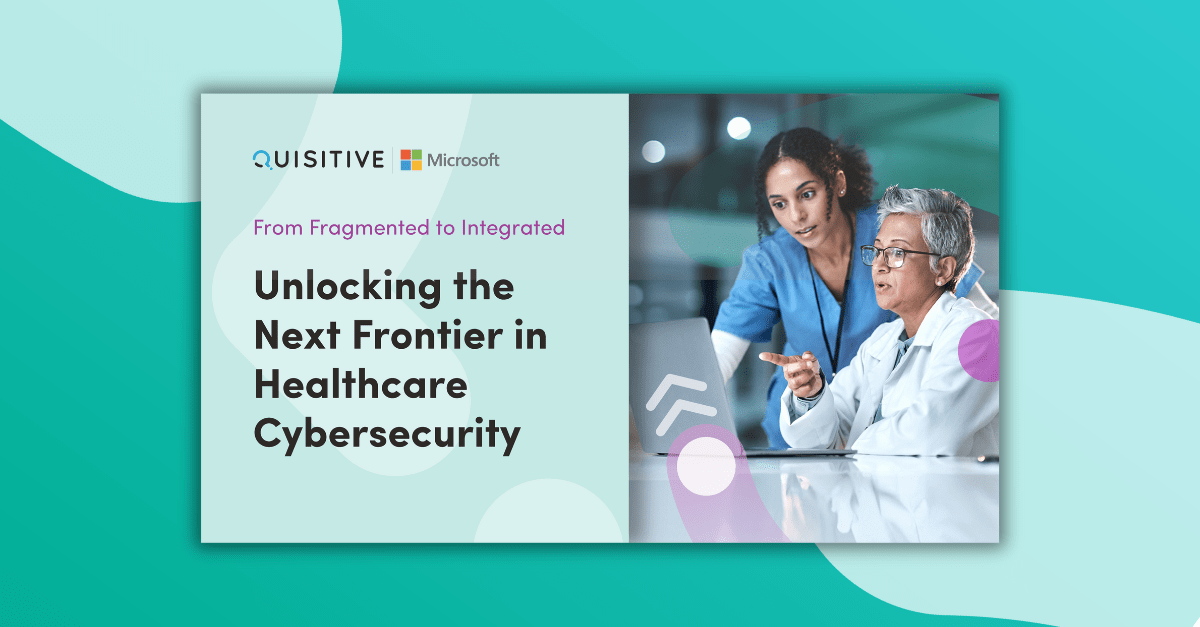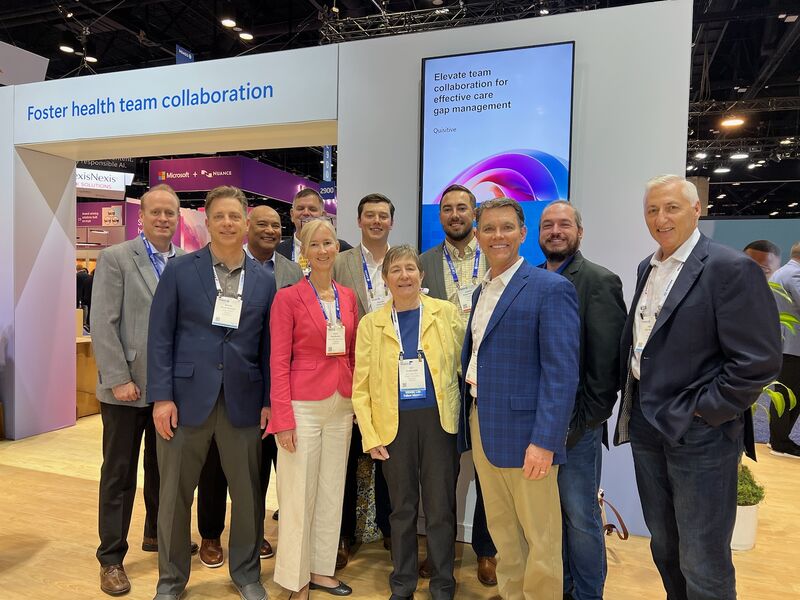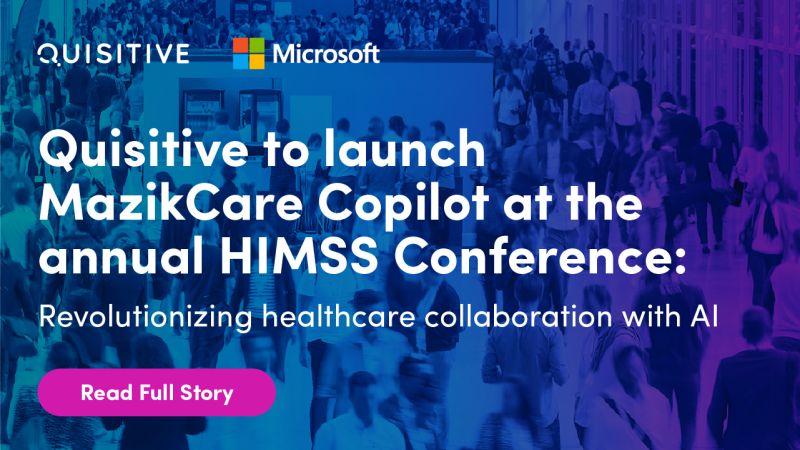New uses and applications of technology are increasing, partly thanks to Covid-19. While already rapid, the pandemic has served to accelerate the pace of digital innovation and transformation. From the new adoption of telehealth to predictive analytics, digital contact tracing, and remote patient monitoring, the pandemic has fast-tracked digital transformation across the healthcare industry.
Throughout the pandemic, Quisitive has anticipated the shifting paradigm of consumerism in healthcare, working to identify the role technology must play to meet new challenges and deliver on the promising new models of care delivery. The sections ahead reflect on the past few years’ massive advances, anticipate upcoming developments, and identify the biggest trends in healthcare technology for 2022 and beyond.
Innovations that will advance healthcare delivery
Ultimately, technology is in service of human needs; it must always adapt to meet the needs of today. And today, the prevailing winds of innovation are driving agile advances in technology. That is the most thrilling aspect of technology today, for me. Over the last two years, healthcare leaders have become aware they must focus on migrating all apps, solutions, and data to the cloud.
Most recently, FHIR capabilities address roadblocks to tech enhancements in healthcare by ensuring cybersecurity and availability of all data for simple, secure exchange. With this infrastructure in place, organizations do not have to replace their entire tech stack – it’s actually much easier. The most exciting thing about healthcare technology today is the increasing popularity of open architecture for seamless communication and secure data sharing. We ensure that healthcare organizations can leverage their existing EMR, point solutions and vendors so that they can integrate new technologies into current workflows and deliver the greatest value to administrators, providers, clinical staff, and patient-consumers.
To address the challenges of today, lean in to the consumerization of healthcare
Open, secure architecture and agile platforms will have great implications for addressing two of the biggest pain points for healthcare organizations today: burnout and the rising cost of providing care. Pandemic care provider fatigue, rotating sickness, and general staffing shortages mean that there are not enough staff and provider resources to accomplish all the tasks needed. In turn, this spurs a vicious cycle, as it increases pressure on the workforce that remains, fueling the likelihood of additional burnout rates. When cloud-based technology is leveraged so that systems can communicate, openly share data, and accomplish tasks, efficiencies are realized. Nurses and front-office staff will spend less time on manual data entry and ordering processes, because the systems will be able to automatically input and transfer data. Schedule management, prescription fulfillment, form entry, data management, and more will become automated, freeing up valuable clinical and administrative bandwidth and time so that they can rededicate it to patient care.
On the other hand, the costs of providing care are rising. The existing supply chain technology built twenty years ago is not equipped to respond to the disruptions and inconsistencies of today’s supply chain. Without deep visibility into inventory, consumption, and pricing, healthcare has always operated on a “Just in Case” supply chain mentality, which resulted in waste. Now, healthcare must move from “Just in Case” to “Just in Time” inventory management, so that forecasting, ordering, pricing, and inventory management are in sync and based on data-driven consumption, transparent pricing, and accurate timelines. This will help reduce the bloat in procurement and inventory management and can mitigate the effect of shrinking margins on the industry as a whole.
Healthcare technology must become ‘situationally aware’
Throughout the pandemic, Quisitive has anticipated the shifting paradigm of consumerism in healthcare, working to identify the role technology must play to meet new challenges and deliver on the promising new models of care delivery. From our Supply Chain Management and eProcurement solutions to Back to Work and VaccineFlow, we were able to leverage Microsoft Cloud for Healthcare infrastructure to create responsive solutions that support organizations facing immediate and very real challenges today.
More broadly, as individuals, we’ve become accustomed to the idea that technology responds to what we need at any given moment, even if we did not originally plan for it. Consider Uber; the app is able to update in real-time in response to an array of unforecasted factors, including traffic, changing locations, payment models, additional stops, human whim, and more. Every industry needs to adapt in this way. Healthcare must continue its focus on leveraging AI and cloud capabilities so that we can make use of the data we already have to plan for situationally aware decisions.
AI, NLP, and other innovations will unleash the promise of virtual care
About seven years ago, we began an autonomous application thought exercise designed to build out technology applications that thoughtfully apply to very real patient care pathways. For instance, we might know that three days after a patient returns home following surgery, she needs to take a series of medications and change bandages. We developed dashboards knowing that certain activities need to be performed, so we can build in reminders along the way. This way we can scale recovery management for thousands of patients at a time, instead of placing the burden of individual and direct outreach on a small and overworked nursing team. Our initial version of Mazik CarePath was the first step in orchestration of care leveraging tech automation.
Now, we are making the tool even smarter by building AI into the algorithm. Based on a series of factors, patient data inputs, and timing, the technology will create necessary recommendations and interventions to optimize the best next step in care management. The world of connected devices is making this process even smarter. Remote patient monitoring devices, such as blood pressure cuffs, blood sugar monitors, anticoagulant devices are already connected and can securely provide data so that the system can offer intelligent recommendations. Now, back to that concept of leaning into consumerization. Consumers expect that their wearables will also play a role in their healthcare decisions. Apple, Samsung, and Google devices connect data on a daily basis; connecting these devices to patient portals and the EMR will deliver another layer of value – and increase patient satisfaction. It’s up to us to manage security guidelines and ensure patient privacy is respected.
Our top development priorities: deployment speed, the patient experience, healthcare at home
From founding to present day, Quisitive strives to develop agile applications that may be practically applied to create efficiencies and address the very real pain points of today. With that in mind, there are three main areas we’re focusing on to deliver the greatest value to our partners:
- Expediting deployment
The general idea is that faster deployments yield faster value for our partner organizations. As there are so many nuances involved in data interoperability, it can cause delays in implementation. Leveraging four different technologies on Microsoft Azure, we’re developing a pre-built EMR connector that is already configured to seamlessly integrate with Epic, Cerner, and many other EMRs. It will reduce deployment time significantly. It will enable us to instantly connect everything within the platform on a unified tech stack, to vastly reduce implementation timelines – and headaches for any tech stakeholders.
- Enhancing the patient experience
The patient experience is infamously fragmented. With various EMR integrations, a single patient may have multiple patient portal accounts, sometimes as many as four to five. We believe the experience should be decentralized from the EMR, and reimaged around the patient-consumer him or herself. This will help create a more connected system that can automatically deliver health insights for both patients and providers, integrate data from wearables and daily life, and deliver the benefits of remote patient monitoring (RPM) more directly.
- Expanding virtual health scenarios
Covid-19 will continue to drive new ways of delivering healthcare. Home healthcare will continue to grow in popularity and importance, especially as the hospital becomes more a site of care for emergency application and long-term healing. Quality of care measures will continue to reinforce these trends, as deeper, long-term and remote relationships will equip healthcare providers with the ability to help manage better daily quality of life for patients with chronic conditions. To that end, we are working to support new ways for providers and patients to connect virtually – both for visits and RPM. We will leverage Microsoft technology, including Teams, to facilitate these appointments and integrate patient-generated healthcare data directly into the patient portal and EMR.
Ultimately, innovations on the backend will power human-centric solutions designed to respond to the real-time needs, momentary changes, and incoming data generated by patients and providers. Building on the cloud will usher in a new era of secure, agile technology developed in service of today’s workflows and patient journeys. Completely new healthcare scenarios will be identified, such as the emerging use case of the virtual ICU.
Digital health platforms connected to wearables and patient remote monitoring devices will lighten the burden on hospital staff and the emergency department by enabling quality care for specialized treatments in the safety and comfort of a patient’s own home. The virtual ICU, integrated patient portals, and other enhancements to the healthcare experience like these, will unlock new workflow efficiencies and cost savings, drive greater patient satisfaction, deepen patient-provider relationships, and result in a higher overall quality of patient care – both inside and outside of the hospital walls.

;)


